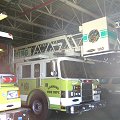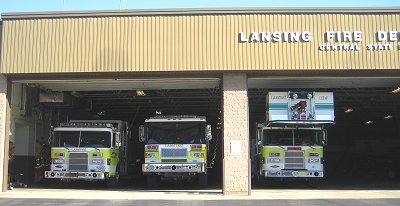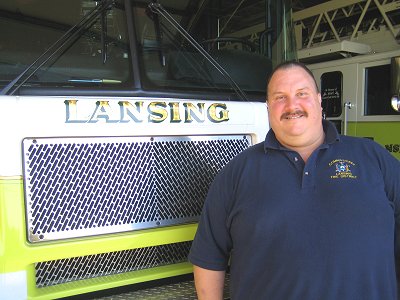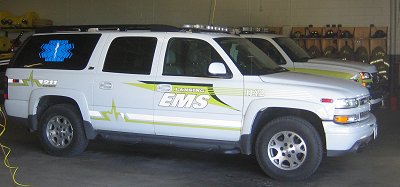- By Dan Veaner
- Around Town
 Print
Print  The Lansing Fire District tax is a pretty small chunk of our overall property tax burden. This year it was a fraction over $1.02 per $1000 of assessed value. It only topped the one dollar mark in 2006. Compared to the School District's $22 million budget, the Fire District's $1.3 million budget doesn't seem like much. The Lansing fire tax rate is one of the lowest in Tompkins County, only about a quarter of what Ithacans pay.
The Lansing Fire District tax is a pretty small chunk of our overall property tax burden. This year it was a fraction over $1.02 per $1000 of assessed value. It only topped the one dollar mark in 2006. Compared to the School District's $22 million budget, the Fire District's $1.3 million budget doesn't seem like much. The Lansing fire tax rate is one of the lowest in Tompkins County, only about a quarter of what Ithacans pay.With fuel and other prices soaring out of control you would expect fire district taxes to do the same. But that is not happening in Lansing, in large part because of conservative long range planning that lays out spending over the next 20 years. "Some line items go down, some go up," says Robert Wagner, Lansing Fire Commissioners Chairman. "We look at each line item and we look to see where the bottom line is. Then we may adjust or cut the budget. We've done a pretty good job up to this point."

A large part of Lansing's low emergency response costs is that the fire department is manned entirely by volunteers. But with the cost of aerial trucks close to a million dollars and pumper/tankers at about $400,000, maintaining four fire houses, and fuel prices more than double what they were only a few years ago, the real reason costs to taxpayers are so low is conservative planning and sticking to the plan.
Wagner says that two years ago when it looked like gas prices were going to go through the roof the commissioners doubled the line item for diesel and gasoline, heating fuel light, and water. "We weren't really sure where to go with it," he says. "We decided we were going to shoot high for fuel. That year we budgeted in the neighborhood of $80,000 and the year before was probably about half that."
Lansing's fire department has eight big trucks and nine smaller vehicles, including two pumper tankers, two pumpers, an aerial (ladder truck), a reserve pumper, two chiefs' vehicles, 2 EMS vehicles, a pickup truck, a couple of ATV-sized vehicles (one of which can carry a stretcher), and a rescue boat. The department has cut down on the number of big trucks by purchasing pumper/tankers, which takes on the functions of two separate trucks.

Robert Wagner is Fire District Commission Chairman
as well as President of the Lansing Fire Department
One pumper/tanker is kept in North Lansing, an engine in the Village of Lansing, a pumper/tanker in Lansingville, and the rest are kept at Central Station. The outlying stations don't go on as many calls as Central Station, so Chief Scott Purcell makes sure they are swapped around periodically to make sure they are all being used and in good shape.
The fire department gets its fuel from the Town Highway Department. It pays the same rate as the Town, and does not pay fuel tax. To date diesel has averaged $3.670 per gallon this year, though it has come down to $3.0141 in October. Last year the average was $2.363, and in 2006 it was 2.228. Wagner estimates the big trucks get about six or eight miles per gallon. That's about two gallons per truck from Central Station to the Shops at Ithaca Mall, round trip.
"That's pretty good for a big vehicle," he says. "They are all kept in top shape and get full service once a year. Our people here do truck checks every Tuesday night. They go through it and make sure all the fluid levels are OK. The big ones get checked every two months throughout the year. And obviously they check the gauges going down the road to make sure they have oil pressure."
Wagner says that in March of this year $15,000 had been spent on fuel. Assuming the same for the other three quarters, that leaves a $20,000 buffer in the fuel budget. But while the average person can decide not to drive to Walmart on any given week, the fire department doesn't have the luxury of deciding not to go when an emergency call comes in. A $60,000 contingency line item is built into the budget to cover that, or other unexpected costs such as replacing damaged fire hose.
The approach Lansing fire commissioners have taken is to keep to the bottom line in the 20 year plan even when the unexpected happens. "Some line items go down, some go up," Wagner says. "We look at each line item and we look to see where the bottom line is. Then we may adjust or cut the budget. Fuel didn't really affect it a lot, because things change (in the 20 year plan)."

Money that is not spent in a budget year goes into reserve funds to provide money for capital projects or equipment purchases. These reserves play an important part in keeping taxes down when a new truck or building project comes along. Pumper/tankers cost around $400,000 new. The district paid about $750,000 for the aerial in 2000. Wagner says that it would cost almost $1 million today. He says the cost of new fire equipment jumps from 5% to 7% per year.
Because of these reserves the department may only have to bond $150,000 to $200,000 when they buy a new truck, which the taxpayers pay over ten years. District Treasurer George Gesslein has said that when the time comes to build a new fire station in the Village of Lansing about half the money needed may come from reserves. In the meanwhile the reserves generate interest income until the money is actually used. And the district has almost no debt.
The other benefit long term planning has had for district taxpayers is that balancing projected needs means residents don't pay more to build reserves in the short run. Wagner says it wasn't necessary to raise the budget line for fuel this year, because the adjustment two years ago was ample. At the same time the district only saves for projected projects. "It didn't appear that it was going to six or eight dollars a gallon, so we didn't raise it too far," he says. "All the money is used somewhere. We try to give ourselves enough room that we're not going to get cut short."
----
v4i40



